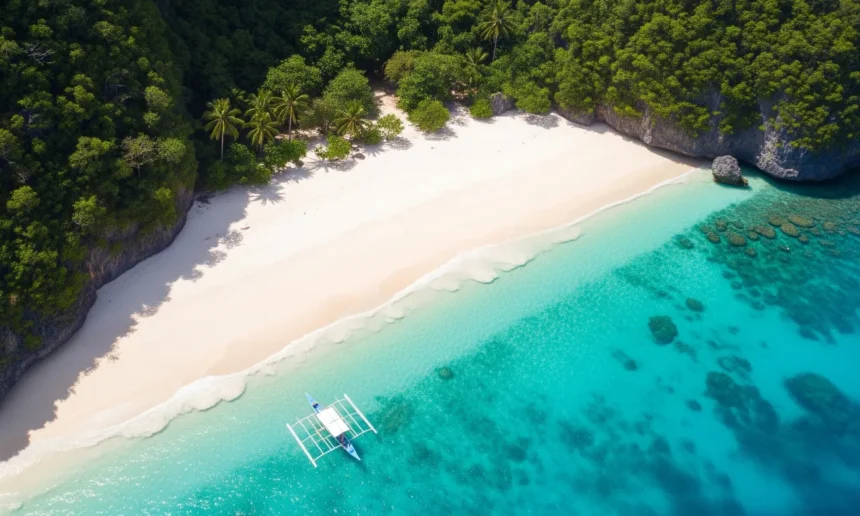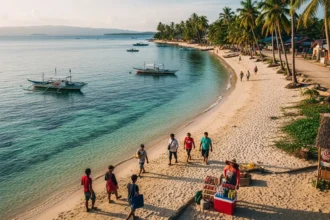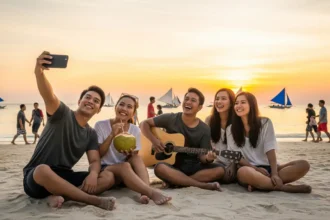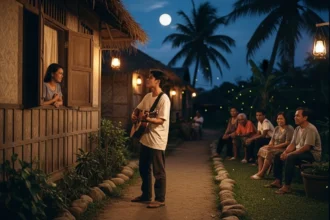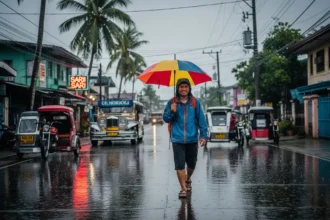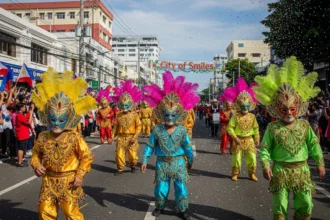The Siren Song of the Unseen: Beyond the Famous Shores
Imagine a stretch of powdery white sand, kissed by waters so clear they shimmer in a hundred shades of blue. The only sounds you hear are the gentle lapping of waves and the whisper of the wind through palm trees. No blaring music. No endless rows of vendors. Just pure, untouched paradise. This is not a fantasy. This is the reality of the hidden beaches Philippines, the secret havens that often outshine their more famous counterparts. We have to ask a compelling question: Why does Boracay dominate the conversation when so much more beauty lies waiting to be discovered?
- The Siren Song of the Unseen: Beyond the Famous Shores
- 👑 The Reign of Fame: Why Boracay Dominates the Conversation
- 🌊 Luzon’s Coastal Charms: Beyond the Usual Suspects
- 🌊 Visayan Vistas: Where the Blues Run Deep
- 🌴 Mindanao’s Mystique: Untamed Shores and Vibrant Cultures
- 🗓️ Timing is Everything: Best Seasons for Your Beach Escape
- 🗺️ The Journey to Paradise: How to Get There
- 💰 Budgeting for Bliss: Estimated Travel Costs (3-Day Trip)
- ⚖️ Myth vs. Reality: A Final Look at Mindanao Travel
- 🤔 FAQs for the Adventurous Traveler
- The Final Invitation: Unwrapping a Hidden Gem
- 🧭 References
Boracay, with its iconic White Beach, has rightfully earned its fame. It is beautiful, accessible, and offers a vibrant experience. But its very popularity has made it a victim of its own success, often leading to overcrowding and a commercialized atmosphere that can detract from the natural splendor. This article is your invitation to look beyond the obvious, to embark on an adventure that promises pristine shores, vibrant marine life, and authentic local culture, all without the overwhelming crowds. We will unveil the underrated gems that truly rival, and often surpass, the Boracay experience. So, pack your bags, adventurous soul. Get ready to discover the Philippines’ best-kept secrets, the forgotten beaches that are truly better than Boracay.
👑 The Reign of Fame: Why Boracay Dominates the Conversation
Boracay Island holds an undeniable reign over the Philippine tourism landscape. Its name is synonymous with “paradise” for many, both local and foreign tourists. This dominance isn’t accidental; it’s a result of decades of strategic marketing, unparalleled accessibility, and a unique combination of natural beauty and vibrant commercial activity that caters to a wide range of travelers.
The island’s marketing prowess has been formidable. For years, Boracay was the face of Philippine tourism campaigns, its iconic White Beach plastered on billboards and featured in international travel magazines. This consistent exposure cemented its image as the quintessential tropical getaway. Secondly, its accessibility is a major factor. With multiple daily flights from Manila and other major cities to nearby airports (Caticlan and Kalibo), getting to Boracay is relatively straightforward compared to more remote islands. The well-developed infrastructure, from diverse accommodation options to various transport services, further simplifies the travel experience for first-time visitors. Finally, Boracay offers a complete package that appeals to mass tourism. It’s not just about the beach; it’s about the lively nightlife, the wide array of restaurants, the water sports, and the overall “party island” vibe. This combination of natural beauty and commercial vibrancy created a powerful draw, making it the default choice for many seeking a fun-filled beach vacation. However, this very dominance has led to its biggest challenge: over-tourism, which often leaves travelers yearning for a more serene and untouched paradise.
🌊 Luzon’s Coastal Charms: Beyond the Usual Suspects
Luzon is often celebrated for its towering mountains and rich historical sites, but its coastline holds just as much magic – if not more. Scattered across this vast island are hidden gems that rival Boracay’s powdery sands and turquoise waters, yet remain blissfully uncrowded. These places aren’t just beaches; they’re sanctuaries where the rhythm of the waves replaces city noise, and nights are lit not by neon lights but by starlit skies.
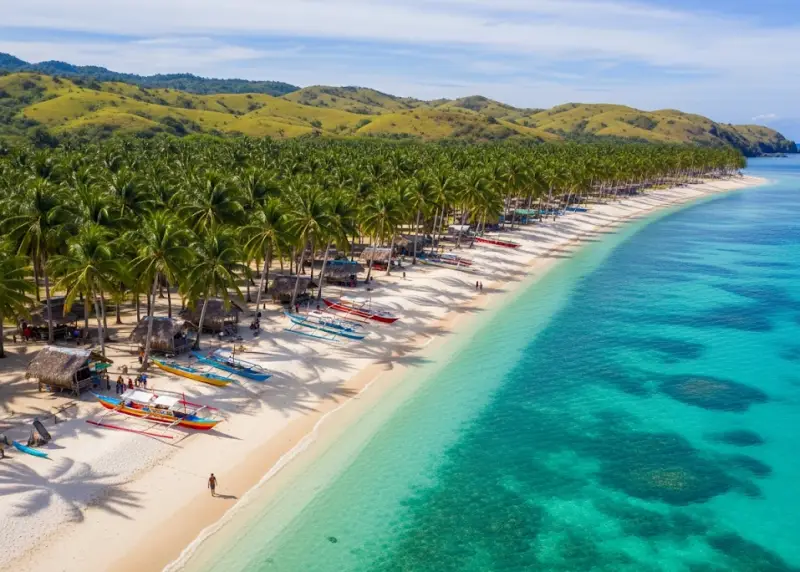
🏝 Calaguas Islands, Camarines Norte
The Calaguas Islands are often described as the “Boracay of the North”, but without the overdevelopment. At Mahabang Buhangin (Long Beach), you’ll find a breathtaking stretch of powdery white sand where the only footprints are yours and maybe a few other campers. The water is crystal clear – perfect for swimming, snorkeling, or just floating as you take in the serene surroundings.
How to Get There:
- Ride a bus from Manila to Daet or Paracale (8–10 hours, ₱500–₱700).
- From Paracale or Vinzons port, hire a boat (2–3 hours, ₱2,500–₱3,500 per boat good for 6–8 people).
Entrance & Fees:
- Environmental fee: ₱120–₱150 per person.
- Boat rentals depend on your group size and negotiation skills.
Accommodation & Food:
- Rustic beach camping is the way to go here. You can rent tents (₱300–₱500) or bring your own.
- Some locals sell freshly cooked meals (₱100–₱150 per meal), but it’s best to bring your own supplies, including drinking water.
Best Time to Visit:
- Summer months (March to May) when the seas are calm and skies are clear. Rainy season can make boat rides risky.
What to Bring:
- Tent, sleeping mat, mosquito repellent, portable stove, snacks, and lots of water.
- Don’t forget snorkeling gear if you want to see the coral gardens nearby.
What to Expect:
- No electricity, no Wi-Fi, no big resorts – just the stars, the sand, and the sea. For many, it’s a rare chance to disconnect and reconnect with nature.
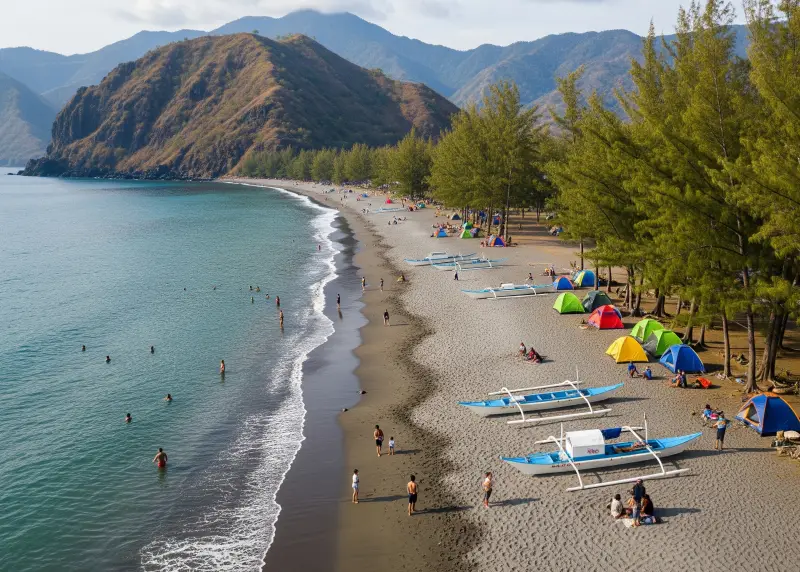
🏖 Nagsasa Cove, Zambales
Nagsasa Cove is a surreal masterpiece of nature, with ash-gray sands formed by Mt. Pinatubo’s eruption, surrounded by pine trees and dramatic mountains. Unlike Boracay, you won’t find clubs or malls here – instead, you’ll discover peace, fresh air, and a horizon that stretches endlessly. The cove is also loved by campers who want to sleep under the stars, lulled by the sound of waves.
How to Get There:
- From Manila, ride a bus to San Antonio, Zambales (4–5 hours, ₱300–₱350).
- Take a tricycle to Pundaquit Beach (₱30–₱50 per person).
- From there, rent a boat to Nagsasa (₱1,500–₱2,000 roundtrip for 4–5 people, passing scenic rock formations along the way).
Entrance & Fees:
- Environmental fee: ₱100–₱150.
- Some camping sites charge ₱200–₱300 per tent space.
Accommodation & Food:
- Bring your own tent, or rent one from local operators (₱300–₱500).
- There are small sari-sari stores selling drinks and canned goods, but it’s best to bring cooked meals, snacks, and plenty of water.
- Grilling is common here, so many visitors bring fresh seafood or meat to cook by the shore.
Best Time to Visit:
- November to May (dry season). Waves can be rough during the rainy months.
What to Bring:
- Tent, flashlight, cooking set, extra clothes, and waterproof bags for gadgets.
- Since nights can get surprisingly chilly because of the mountain winds, bring a light jacket or blanket.
What to Expect:
- Stargazing is magical here due to the lack of city lights.
- You can hike nearby hills for panoramic views of the cove.
- Unlike Boracay, Nagsasa is about quiet reflection – a place where time slows down.
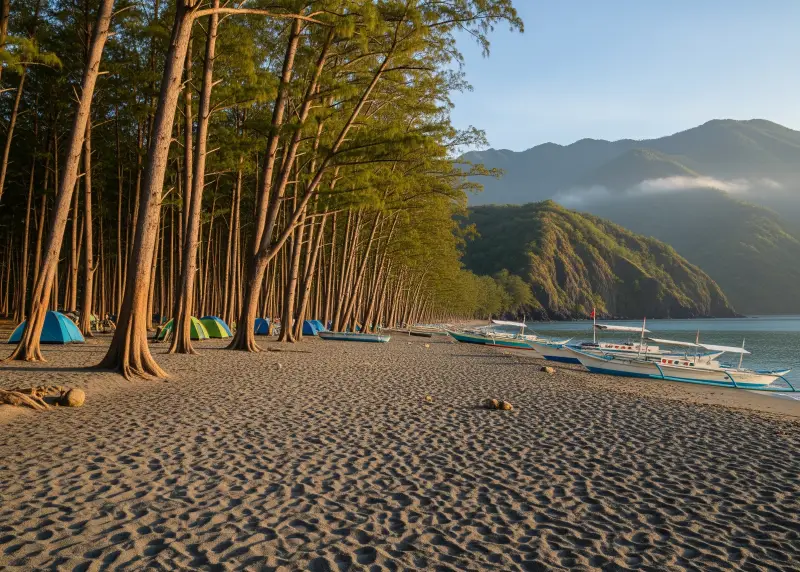
🏕 Anawangin Cove, Zambales
If Boracay is nightlife and luxury, Anawangin Cove is simplicity and raw beauty. Known for its unique landscape of volcanic ash-colored sand and pine-like agoho trees, this cove feels like you’ve entered another world. The shoreline is wide, the water is calm, and the backdrop of mountains makes it picture-perfect.
How to Get There:
- Take a bus from Manila to San Antonio, Zambales (4–5 hours, ₱300–₱350).
- From Pundaquit Beach, rent a boat to Anawangin (₱800–₱1,200 for a small group).
Entrance & Fees:
- Environmental fee: ₱100–₱150.
- Tent space rental: ₱200–₱300.
Accommodation & Food:
- Pure camping experience – no hotels or resorts.
- Bring your own tent, cooking supplies, and food. Some operators provide package deals that include boat transfers, tents, and meals (₱1,200–₱1,800/person).
Best Time to Visit:
- Summer months (March–May) for calm seas and clear skies.
What to Bring:
- Camping gear, flashlight, mosquito repellent, portable stove, water.
- Waterproof bags are a must, especially during boat rides.
What to Expect:
- Stargazing opportunities and bonfire nights.
- You can also hike up nearby hills for breathtaking views of the cove.
- No signal in most areas – a true digital detox.
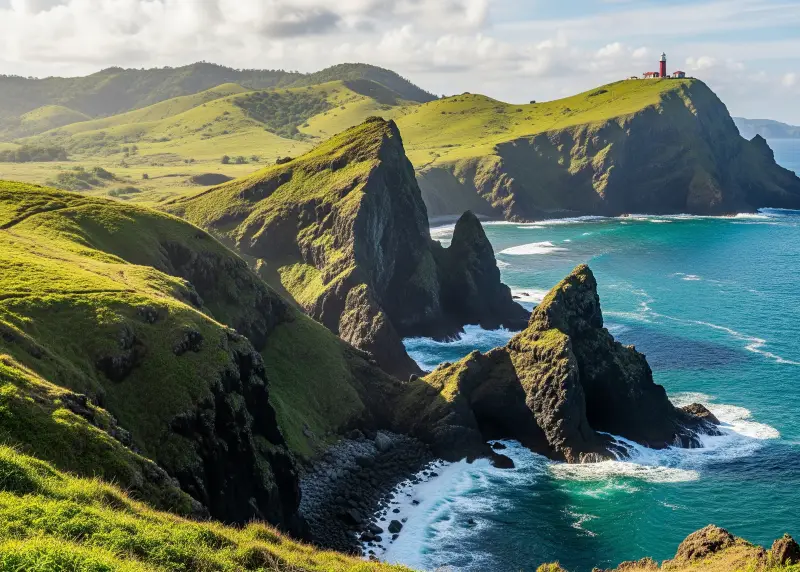
🌅 Palaui Island, Cagayan
Dubbed as one of CNN’s “World’s Best Beaches,” Palaui Island in Cagayan is a hidden gem at the northern tip of Luzon. Untouched and rugged, it offers white-sand beaches, lush mangrove forests, and rolling hills. Its remoteness makes it perfect for adventurous travelers who want to disconnect completely.
How to Get There:
- Fly to Tuguegarao (1 hr from Manila), then ride a van/bus to Sta. Ana, Cagayan (3–4 hrs).
- From San Vicente Port, hire a boat to Palaui Island (₱3,000–₱3,500 roundtrip, good for 6–8 people).
Entrance & Fees:
- Environmental fee: ₱50–₱100.
- Guide fee: ₱300–₱500 for hikes.
Accommodation & Food:
- Homestays are available in Sta. Ana, but on the island itself, camping is the main option.
- Bring your own food and water as supplies are limited.
Best Time to Visit:
- March to June for sunny weather.
- Avoid during typhoon months (September–November).
What to Bring:
- Tent, water, dry bags, hiking shoes if you plan to trek Cape Engaño Lighthouse.
What to Expect:
- The trek to Cape Engaño Lighthouse is a must, offering panoramic ocean views.
- Secluded beaches where you can often find yourself alone.
- Minimal facilities – prepare for back-to-basics living.
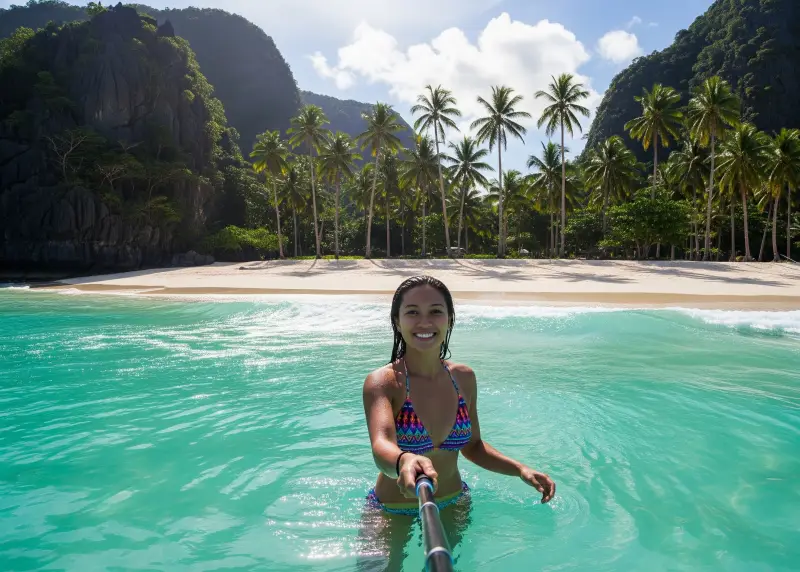
🏖 Caramoan Islands, Camarines Sur
Caramoan gained international attention when it hosted several seasons of the TV show Survivor. But beyond its fame, it remains an underrated paradise with limestone cliffs, hidden lagoons, and powdery beaches. Perfect for island-hopping lovers.
How to Get There:
- From Manila, take a bus to Naga (8 hrs, ₱600–₱800).
- From Naga, ride a van to Sabang Port (1–2 hrs), then a boat to Caramoan (2 hrs).
Entrance & Fees:
- Environmental fee: ₱50.
- Island-hopping tours: ₱1,500–₱2,500 per boat (good for 6–8 pax).
Accommodation & Food:
- Resorts and inns are available in Caramoan town (₱800–₱3,000/night).
- Local eateries offer fresh seafood and affordable meals.
Best Time to Visit:
- Dry season (March–May) is best.
- Off-season offers fewer tourists but be prepared for rain.
What to Bring:
- Swimwear, snorkeling gear, dry bags, sunscreen.
What to Expect:
- Island-hopping is the highlight – Matukad, Lahos, and Sabitang Laya Islands are crowd favorites.
- Some islands are so secluded you’ll feel like you’re on your own private beach.
- More facilities than Calaguas or Palaui, but still retains a rustic charm.
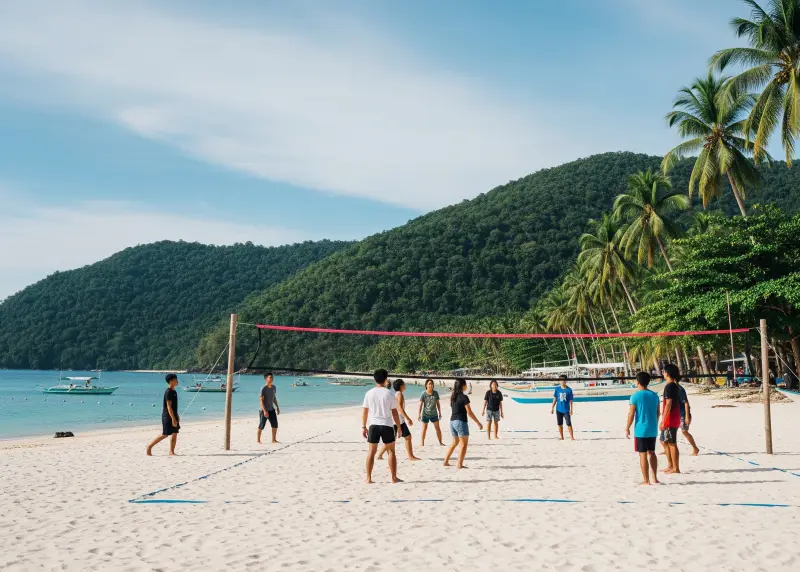
🌊 Anguib Beach, Sta. Ana, Cagayan
Often compared to Boracay for its fine sand and crystal-clear waters, Anguib Beach remains relatively under-the-radar. Its wide beachfront is perfect for family outings or solo getaways.
How to Get There:
- From Manila, fly to Tuguegarao or take a bus to Sta. Ana, Cagayan.
- Take a boat from San Vicente Port to Anguib Beach (₱1,500–₱2,000 per boat, roundtrip).
Entrance & Fees:
- Entrance fee: ₱150.
- Tent pitching fee: ₱200.
Accommodation & Food:
- Campsites are available.
- Bring your own food, but some locals sell fresh seafood for grilling.
Best Time to Visit:
- November–May for dry season.
What to Bring:
- Tent, cooking gear, water, sunscreen.
What to Expect:
- Calm, shallow waters ideal for swimming.
- Less crowded than Boracay – perfect for relaxation.
- A few cottages for rent but expect rustic facilities.
🌊 Visayan Vistas: Where the Blues Run Deep
The Visayas, often called the heart of the Philippines, is blessed with islands where blue seas kiss white sands and life slows down to island time. Beyond Cebu’s resorts or Boracay’s famed shores, there are destinations where the sea feels infinite, the food is fresh from the day’s catch, and the welcome from locals is as warm as the tropical sun. These are the paradises waiting quietly, far from the chaos of crowded tourist hubs.
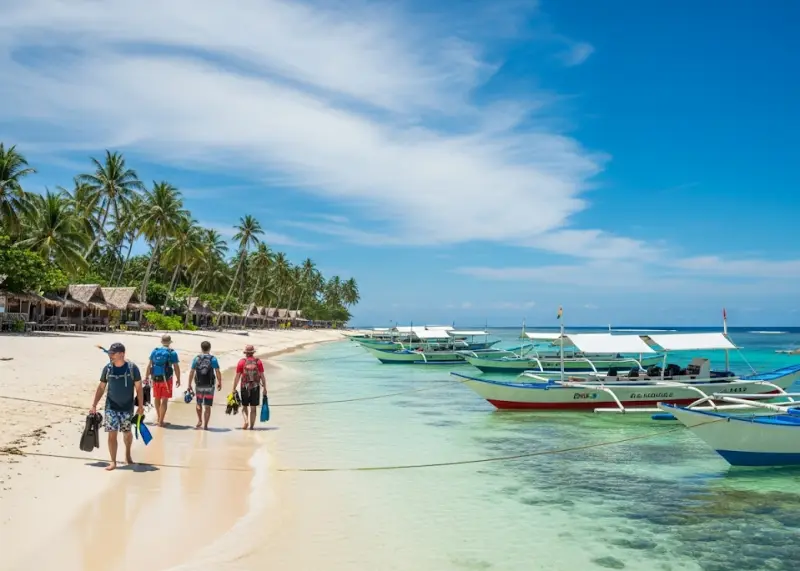
🏝 Malapascua Island, Cebu
Known globally as the only place where you can reliably see thresher sharks, Malapascua is a diver’s dream. But what many don’t realize is that the island itself is a paradise above water. Its star is Bounty Beach, a long stretch of powdery sand lined with small resorts, dive shops, and cozy bars that keep the vibe relaxed and welcoming. It’s far less crowded than Boracay, giving it a bohemian charm loved by both backpackers and families.
How to Get There:
- From Cebu City, take a 4–5 hour bus/van ride to Maya Port (₱200–₱250).
- From Maya Port, ride an outrigger boat to Malapascua (₱100–₱150, 30 minutes).
Entrance & Fees:
- No general entrance fee, but marine sanctuary fees apply for divers (₱150–₱300 per dive).
Accommodation & Food:
- Plenty of budget inns (₱500–₱800/night) and mid-range resorts (₱1,500–₱3,000).
- Local carinderias serve meals for as low as ₱80. Fresh seafood, like grilled squid or kinilaw, is a must-try.
- Western-style cafes and small bars also cater to foreigners.
Best Time to Visit:
- March to June for the best weather and calm seas.
- Thresher shark dives happen year-round, but visibility is best in summer.
What to Bring:
- Snorkeling or diving gear (though rentals are available).
- Sunscreen, eco-friendly toiletries, and cash (no ATMs on the island).
What to Expect:
- Morning boat rides for shark diving.
- Lazy afternoons on hammocks and beach strolls.
- Evenings spent sharing stories with fellow travelers under the stars.
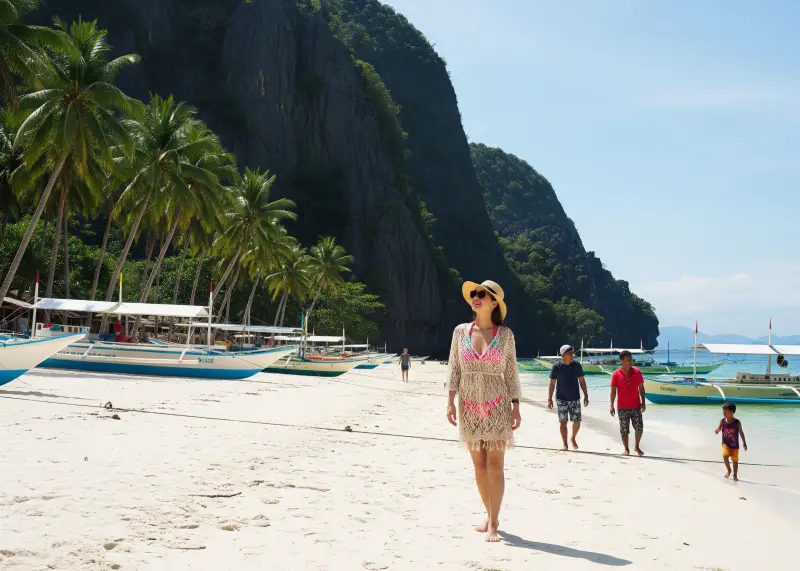
🏖 Gigantes Islands, Iloilo
If you want the raw, rugged side of paradise, head to Gigantes Islands in Carles, Iloilo. Known for its dramatic limestone cliffs, twin beaches, and secret lagoons, this remote cluster feels untouched and wild. The highlight is Cabugao Gamay Island, with its postcard-perfect view of twin white sandbars. Over at Antonia Beach, you’ll find crystal-clear waters and rock formations that make for incredible photos. And don’t forget the food – Gigantes is famous for its cheap, delicious scallops, sometimes sold for as low as ₱1 each.
How to Get There:
- From Iloilo City, ride a bus or van to Estancia Port (4–5 hrs, ₱200–₱250).
- From Estancia, take a boat to Gigantes Norte (1.5–2 hrs, ₱80–₱100).
Entrance & Fees:
- Environmental fee: ₱75–₱100 per person.
- Island-hopping boat tours: ₱1,500–₱2,500 per boat (good for 6–8 pax).
Accommodation & Food:
- Basic homestays and inns (₱300–₱800/night).
- Some package tours include accommodation + meals (₱1,500–₱2,000 per person for 2D1N).
- Seafood is abundant and cheap – scallops, crabs, and oysters are highlights.
Best Time to Visit:
- November to May (dry season).
- Boat rides can be rough during rainy season.
What to Bring:
- Dry bags, snorkeling gear, sunscreen.
- Extra snacks and drinking water (supplies on the island are limited).
- Power banks – electricity is available but limited in some areas.
What to Expect:
- Fewer crowds compared to Boracay, making it perfect for nature lovers.
- Island-hopping is the main activity – expect to see caves, sandbars, and hidden beaches.
- No luxury resorts, just simple accommodations and friendly locals.

🌴 Kalanggaman Island, Leyte
If you’ve ever dreamed of walking on a sandbar that seems to stretch endlessly into the sea, Kalanggaman Island will take your breath away. This small, uninhabited island is famous for its long, powdery white sandbars that extend on both sides of the island, surrounded by turquoise waters. Unlike Boracay, there are no towering hotels here – just pure island bliss.
How to Get There:
- From Cebu City, travel to Ormoc, Leyte via ferry (2–3 hrs, ₱500–₱800).
- From Ormoc, take a bus or van to Palompon (1 hr, ₱150).
- Register at Palompon Ecotourism Office and ride a boat to Kalanggaman (1 hr, ₱3,000–₱3,500 per boat good for 15 people).
Entrance & Fees:
- Environmental fee: ₱150 (locals), ₱500 (foreigners).
- Camping fee: ₱200–₱250.
Accommodation & Food:
- No resorts on the island. Visitors either camp overnight or return on the same day.
- Bring your own food and water – no stores are available.
- Palompon locals often offer catering services for groups.
Best Time to Visit:
- Summer months (March–May) for calm seas.
- Avoid visiting during typhoon season (Sept–Nov).
What to Bring:
- Tent, camping gear, snorkel mask, power bank, eco-friendly sunscreen.
- Extra water supply is essential.
What to Expect:
- Snorkeling in clear waters with colorful corals and fishes.
- Sunset and sunrise views that feel like a private show.
- A pristine, crowd-free island where nature takes center stage.
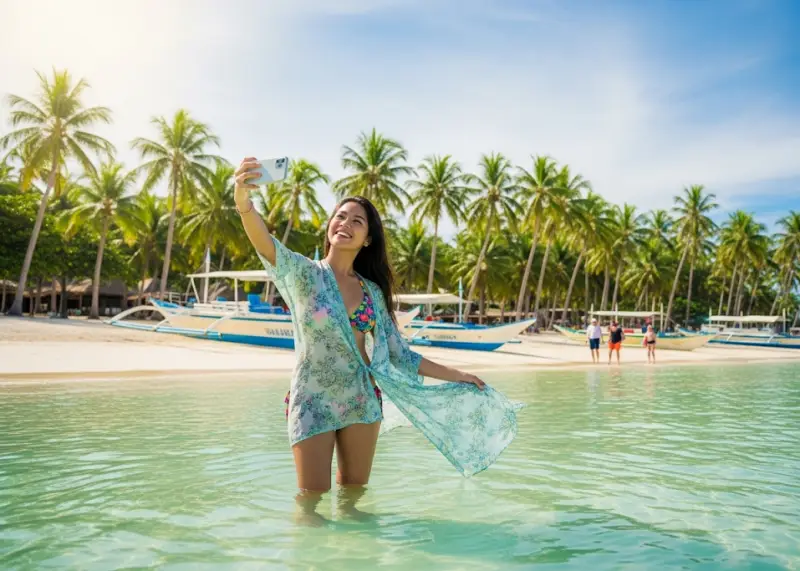
🏝 Bantayan Island, Cebu
Often dubbed “the Boracay of Cebu”, Bantayan Island offers powdery white sand beaches but with a more laid-back, small-town vibe. It’s a place where you can spend mornings swimming in shallow, clear waters, afternoons biking around quaint fishing villages, and evenings enjoying fresh seafood by the shore.
How to Get There:
- From Cebu City, take a 3–4 hour bus ride to Hagnaya Port (₱200–₱250).
- From Hagnaya, take a ferry to Bantayan Island (1 hr, ₱200).
Entrance & Fees:
- Most beaches have free or minimal entrance fees (₱50–₱100).
- Sandbar tours or island-hopping tours: ₱800–₱1,200 per boat.
Accommodation & Food:
- Plenty of affordable resorts and beach cottages (₱800–₱2,500/night).
- Food is a highlight – Bantayan is known for cheap, fresh seafood (try their famous scallops and crabs).
- Cafes and restos serve both local and Western dishes, popular with long-term backpackers.
Best Time to Visit:
- Dry season (November to May).
- Holy Week is very festive here but also the most crowded.
What to Bring:
- Swimwear, snorkeling gear, sunscreen, mosquito repellent.
- Cash – ATMs are limited.
What to Expect:
- Wide sandy beaches like Kota Beach and Sugar Beach.
- A mix of local charm and foreign expat communities.
- A slower pace of life – perfect for those who want to unwind.
🌴 Mindanao’s Mystique: Untamed Shores and Vibrant Cultures
Mindanao often carries a reputation shaped by headlines, but for travelers who take the leap, the island reveals a world of raw beauty and cultural richness unmatched anywhere in the Philippines. Its shores remain less commercialized than Boracay or Palawan, giving visitors a chance to experience beaches and islands in their purest, most authentic form. Here, every trip isn’t just a vacation – it’s a cultural journey into the heart of Filipino diversity.
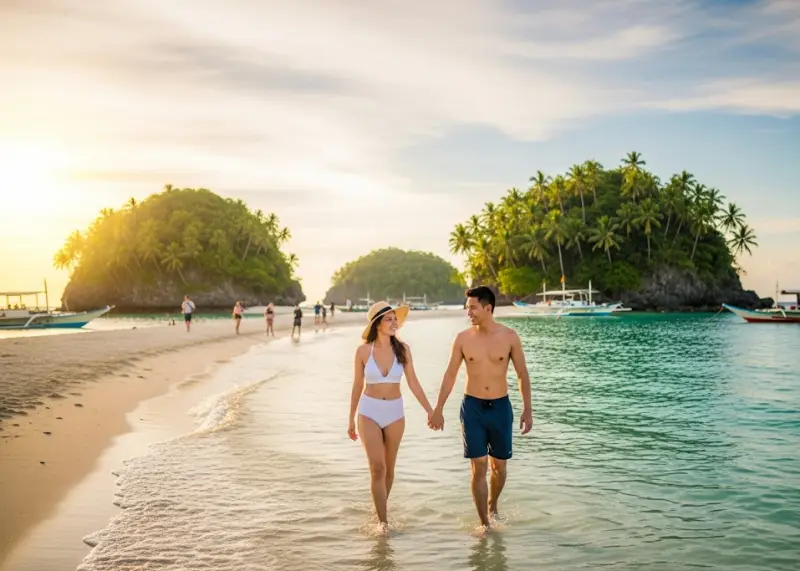
🏝 Britania Group of Islands, Surigao del Sur
Imagine sailing through an archipelago of 24 pristine islands and islets, each with powdery white sand and turquoise waters as clear as glass. That’s the Britania Group of Islands, a paradise for island-hopping enthusiasts. From secluded coves to unique rock formations, every stop feels like stepping into your own private paradise. Unlike Boracay’s bustling White Beach, Britania is all about tranquility and raw beauty.
How to Get There:
- From Davao City, take a bus or van to San Agustin, Surigao del Sur (6–7 hrs, ₱500–₱600).
- From San Agustin, ride a tricycle or habal-habal to Britania Port.
- Rent a boat for island-hopping (₱1,500–₱2,000 good for 6–8 people).
Entrance & Fees:
- Environmental fee: ₱50–₱100 per person.
- Cottage rental (optional): ₱200–₱500.
Accommodation & Food:
- Resorts and homestays are available in San Agustin (₱500–₱1,500/night).
- Fresh seafood meals can be arranged at resorts or by locals (₱150–₱300 per meal).
- Best to bring snacks and water for island-hopping.
Best Time to Visit:
- March to May (dry season). Avoid July–October when seas can get rough.
What to Bring:
- Swimwear, dry bags, snorkeling gear, and extra drinking water.
- Sunscreen and a wide-brimmed hat for long boat rides.
What to Expect:
- Popular islands include Hagonoy, Boslon, and Naked Island.
- Crystal-clear waters for snorkeling.
- A quiet, less-commercialized atmosphere – perfect for those seeking escape.
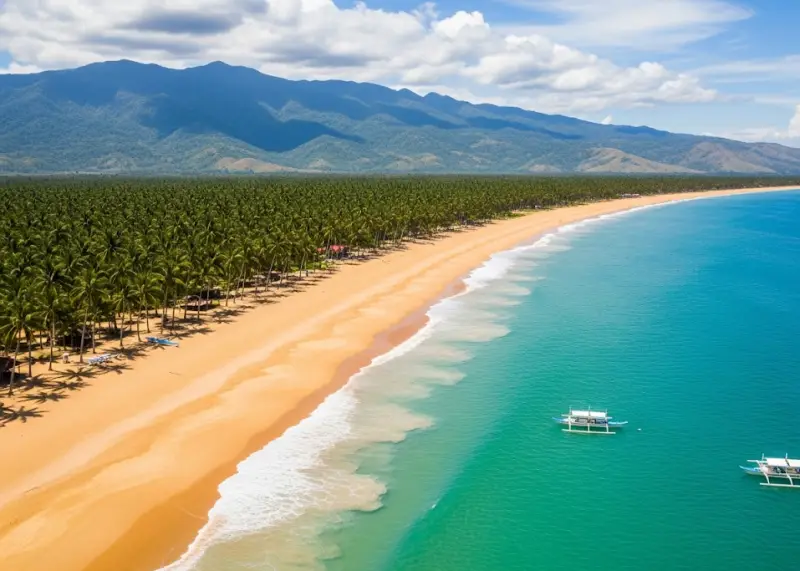
🌊 Dahican Beach, Davao Oriental
Known as Mindanao’s surfing capital, Mati City is where laid-back beach life meets vibrant local culture. The star is Dahican Beach, a 7-km stretch of powdery white sand loved by surfers, skimboarders, and sea turtle conservationists. Beyond the beach, you’ll find Sleeping Dinosaur Island, a natural land formation best viewed from above, and the Subangan Museum, which showcases Davao Oriental’s rich history and culture.
How to Get There:
- From Davao City, ride a bus or van to Mati City (4–5 hrs, ₱300–₱400).
- From Mati town proper, tricycles and habal-habal rides can take you to Dahican Beach (₱50–₱100).
Entrance & Fees:
- Dahican Beach is generally free to access.
- Some resorts charge ₱50–₱100 for day use.
Accommodation & Food:
- Beachfront resorts and homestays range from ₱500–₱2,000/night.
- Fresh seafood is abundant; carinderias serve meals starting at ₱70–₱100.
- Some resorts have restos offering local and international dishes.
Best Time to Visit:
- Year-round, but surfing is best from October to March.
What to Bring:
- Swimwear, rash guards, sunscreen, and surf/skimming boards (rentals also available).
- Snacks and water if planning long stays at the beach.
What to Expect:
- A youthful, local vibe with surfers and conservation groups.
- Sea turtles nesting in the area (seasonal).
- A strong sense of community and warmth from the locals.
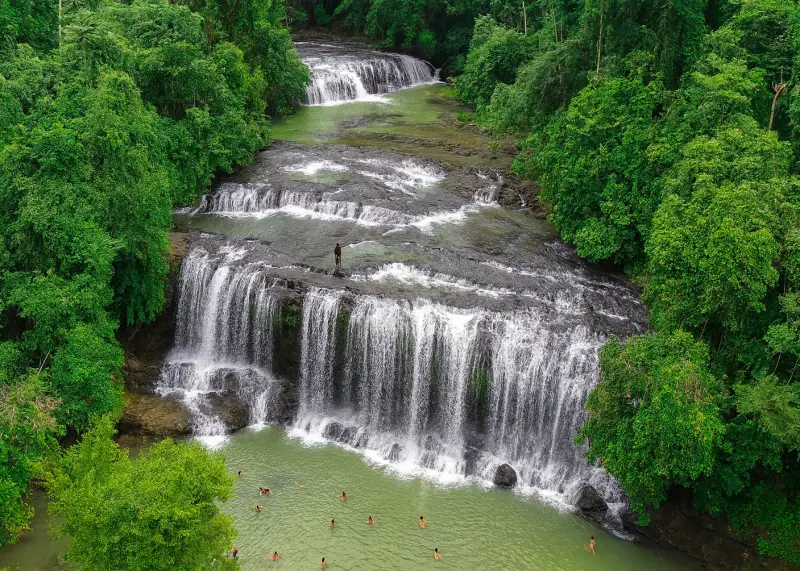
🏖 Tagbilat Falls & Coastal Shores, Sindangan, Zamboanga del Norte
Sindangan is a rising gem in Zamboanga del Norte. While Tagbilat Falls is its star – a cascading multi-tiered waterfall surrounded by lush greenery – the nearby coastal areas offer untouched, serene beaches where you can swim in calm waters and mingle with locals. Unlike commercial beaches, these shores are quiet, free of large crowds, and full of authentic provincial charm.
How to Get There:
- From Dipolog City, take a bus to Sindangan (2–3 hrs, ₱150–₱200).
- From Sindangan proper, ride a habal-habal to Tagbilat Falls and nearby coastal spots.
Entrance & Fees:
- Tagbilat Falls: ₱20–₱50 environmental fee.
- Beaches are mostly free; some locals charge minimal entrance (₱30–₱50).
Accommodation & Food:
- Small inns and pension houses in Sindangan (₱300–₱800/night).
- Eateries and carinderias serve fresh fish and home-cooked meals (₱60–₱100).
- Bring your own snacks and drinks if visiting secluded areas.
Best Time to Visit:
- Summer (March–May) for calm seas and sunny skies.
What to Bring:
- Lightweight clothes, waterproof sandals, water bottles, and snacks.
- Tent and camping gear if you want to sleep by the beach.
What to Expect:
- Refreshing swim at Tagbilat Falls.
- Tranquil beaches where you’ll often be the only visitor.
- Warm conversations with locals who love sharing stories of their coastal life.
🗓️ Timing is Everything: Best Seasons for Your Beach Escape
Choosing the right time to visit these hidden beaches is crucial for maximizing your experience. Weather patterns, crowd levels, and local festivals can all significantly impact your trip.
The Dry Season (December to May): Sun-Kissed Perfection
This is generally considered the best time to visit most Philippine beaches. The weather is typically sunny and dry, with calm waters, making it ideal for swimming, snorkeling, diving, and island hopping.
- December to February: Cooler temperatures, less humidity, and fewer chances of rain. Perfect for those who prefer milder weather.
- March to May: Hotter and drier, ideal for sunbathing and water activities. This is also peak season for many local tourists due to school holidays, so some popular spots might still see more crowds.
The Wet Season (June to November): Lush Landscapes, Fewer Crowds
While this period brings more rain, it also transforms the landscapes into lush, vibrant greens. Many hidden beaches remain stunning, and you’ll encounter significantly fewer tourists, leading to lower prices for accommodations and tours.
- June to August: Occasional rain showers, but often interspersed with sunny periods. Good for those seeking solitude and budget travel.
- September to November: Higher chances of typhoons, especially in the northern parts of the Philippines. It’s crucial to monitor weather forecasts if traveling during these months.
Festivals and Local Events: A Cultural Bonus
Consider aligning your visit with local festivals for a unique cultural experience. For instance, Davao City’s Kadayawan Festival in August offers a vibrant celebration of harvest and indigenous culture, while Camiguin’s Lanzones Festival in October celebrates its sweet fruit. These events can add a rich cultural dimension to your beach getaway.
🗺️ The Journey to Paradise: How to Get There
Reaching these hidden gems often requires a bit more effort than a direct flight to Boracay, but the journey itself becomes part of the adventure, weeding out the mass tourists and preserving the destination’s untouched charm.
Flight First, Then the Adventure
For most of these destinations, your journey will begin with a flight from Manila or Cebu to a regional airport.
- For Calaguas: Fly to Naga (Camsur) or Legazpi (Albay), then take a bus/van to Daet, and finally a boat to Calaguas.
- For Nagsasa Cove: Fly to Clark (Pampanga), then take a bus to San Antonio, Zambales, and a boat from Pundaquit.
- For Malapascua: Fly to Cebu City, then take a bus to Maya Port, and a ferry to Malapascua Island.
- For Gigantes Islands: Fly to Iloilo City, then take a bus to Estancia Port, and a pump boat to Gigantes.
- For Britania Group of Islands: Fly to Surigao City or Butuan City, then take a bus/van to San Agustin, Surigao del Sur, and a boat for island hopping.
- For Mati City: Fly to Davao City, then take a bus/van to Mati City.
- For Tagbilat Falls/Sindangan: Fly to Dipolog City, then take a bus or van to Sindangan. The falls are accessible via local transport from the town proper.
Travel Tips for the Adventurous Soul
- Book Flights in Advance: Especially for peak season, domestic flights can fill up quickly.
- Prepare for Boat Rides: Many hidden beaches require boat transfers. Be ready for potentially bumpy rides, especially during rough seas.
- Pack Light and Smart: A backpack is often easier to manage than a suitcase, especially for island hopping and navigating local transport. Include essentials like sunscreen, insect repellent, and a first-aid kit.
- Bring Cash: ATMs might be scarce or non-existent in remote areas.
- Respect Local Culture: Learn a few basic local phrases, dress modestly when appropriate, and always ask for permission before taking photos of locals.
- Stay Connected (When Possible): While some remote areas have limited signal, having a local SIM card can be helpful for navigation and emergencies.
- Inform a Friend/Family: Let someone know your itinerary, especially when venturing to more remote spots.
💰 Budgeting for Bliss: Estimated Travel Costs (3-Day Trip)
These estimates are for a solo budget traveler and can vary based on your travel style, specific activities, and food choices. They exclude flights to the Philippines and major inter-island flights.
Note: These are rough estimates. Always budget extra for unexpected expenses or splurges.
⚖️ Myth vs. Reality: A Final Look at Mindanao Travel
The media’s portrayal of Mindanao is often a myth. The reality, however, is a beautiful and a truly unforgettable one. The region is filled with a rich culture. It is filled with a beautiful natural wonders. It is filled with a friendly people. The region is a paradise for a backpacker. The region is a paradise for a traveler who is looking for a real adventure. We have to be a more discerning traveler. We have to look beyond the headlines. We have to look beyond the stereotypes. We have to be a more resourceful traveler.
The overgeneralization of Mindanao is a betrayal. It is a betrayal of the people. It is a betrayal of the region. The truth is that Mindanao is not a single entity. It is a collection of provinces, each with its own unique culture, its own unique history, and its own unique beauty. A conflict in one area does not mean that the entire region is at war. This is a crucial distinction. It is a distinction that is often lost in the media’s portrayal. We have to be a more discerning traveler. We have to look beyond the headlines.
🤔 FAQs for the Adventurous Traveler
Q1: Is it safe to backpack in Mindanao? A: Yes, it is generally safe to backpack in major tourist destinations like Siargao, Davao City, Camiguin, and Cagayan de Oro. It’s crucial to research specific areas, follow local advice, and stay informed about any travel advisories, avoiding known conflict zones.
Q2: Do you need travel insurance for these hidden beaches? A: Travel insurance is highly recommended for any international or extensive domestic trip, including to remote areas of the Philippines. It provides coverage for medical emergencies, trip cancellations, lost luggage, and other unforeseen circumstances.
Q3: Is it possible to travel to these less-crowded beaches alone? A: Yes, it is possible. Many of these destinations are welcoming to solo travelers. However, always inform a friend or family member of your itinerary, and consider staying in guesthouses or hostels where you can meet other travelers.
Q4: Do I need to speak Filipino to travel in these remote areas? A: While English is widely understood in major tourist hubs, learning a few basic Filipino or local dialect phrases (e.g., salamat po, magandang umaga) can greatly enhance your experience and interactions with locals in more remote areas.
Q5: What are the best ways to get around these remote islands? A: Local transport options include habal-habal (motorcycle taxis), tricycles, jeepneys, and local buses. For island hopping, bancas (motorized outrigger boats) are common. Be prepared for potentially long and sometimes bumpy rides.
Q6: Are there accommodations available in these hidden beach spots? A: Yes, most of these hidden beaches have accommodations ranging from basic guesthouses and homestays to eco-resorts. Booking in advance, especially during peak season, is advisable.
Q7: What should I pack for a trip to these off-the-beaten-path beaches? A: Pack light, quick-drying clothes, swimwear, reef-safe sunscreen, insect repellent, a first-aid kit, a reusable water bottle, a dry bag for electronics, and comfortable walking shoes or sandals.
Q8: How can I ensure I am traveling responsibly and sustainably? A: Support local businesses, minimize your waste (especially plastics), respect local customs and traditions, avoid disturbing wildlife or natural habitats, and educate yourself about the destination’s unique environmental and cultural sensitivities.
Q9: What if I encounter a language barrier in very remote areas? A: Most Filipinos understand some English. Use translation apps, learn basic phrases, and rely on gestures. Locals are generally very helpful and will often find a way to communicate.
Q10: Is it true that some areas in Mindanao are still dangerous? A: While the vast majority of Mindanao is safe for tourists, there are indeed specific, localized areas that may experience security issues. It’s crucial to consult your embassy’s travel advisories and local government warnings for specific regions before planning your trip. Stick to well-established tourist routes.
The Final Invitation: Unwrapping a Hidden Gem
The hidden beaches Philippines are not just destinations; they are experiences waiting to be unwrapped. They are a testament to the raw, untamed beauty of our archipelago, offering a stark contrast to the well-trodden paths. So, go ahead. Pack your bags. Book that flight. And embark on a journey that will not only change your perception of the Philippines but will also change your perception of yourself. Mindanao, Visayas, and Luzon hold secrets that are waiting to be discovered. The true paradise, my friend, is often found beyond the headlines, in the quiet corners where the sand is whiter, the water is clearer, and the smiles are even warmer. Your adventure awaits.
🧭 References
-
Stories by Wink – 6 Philippine Beaches Like a Secret Hideaway
-
Tripadvisor – Top 10 Best Beaches in the Philippines 2025
-
TripZilla – Best Philippine Beaches 2025
-
Traveling German – Best Beaches in the Philippines
-
South China Morning Post – Philippines Continues Asia Travel Awards Wins



